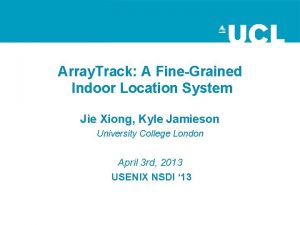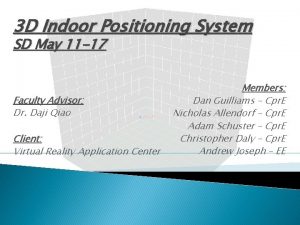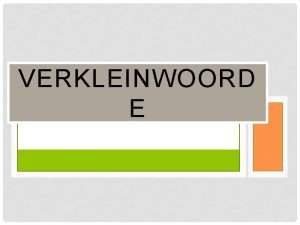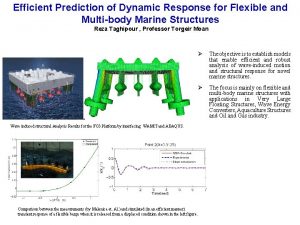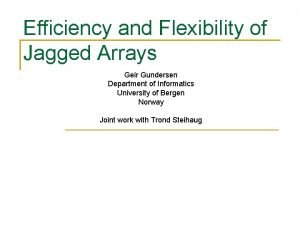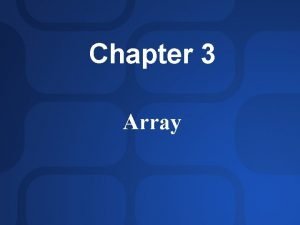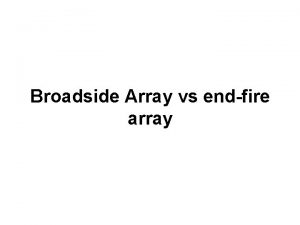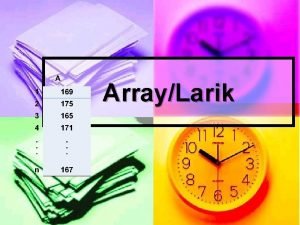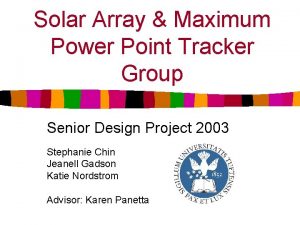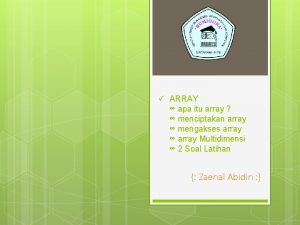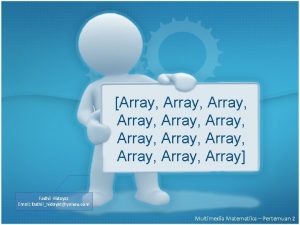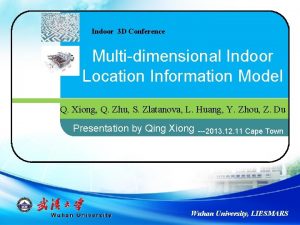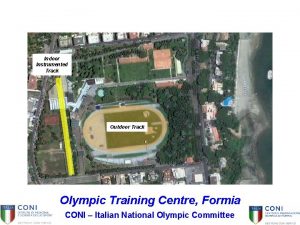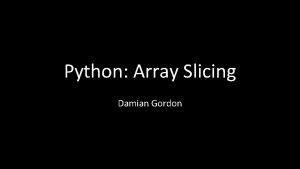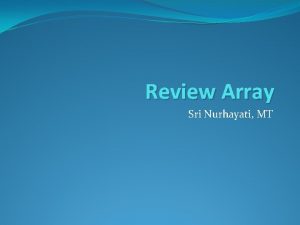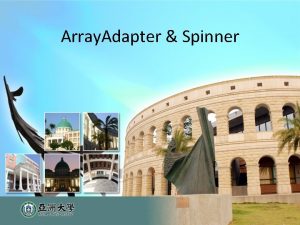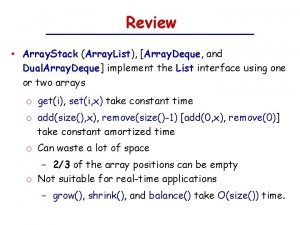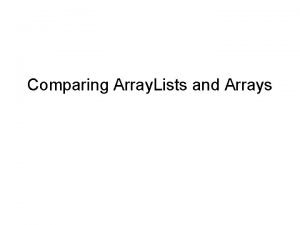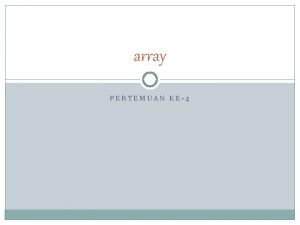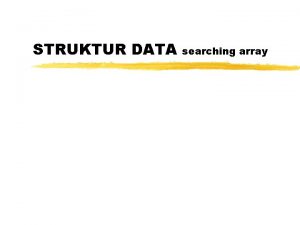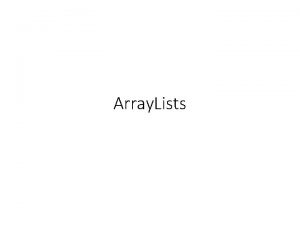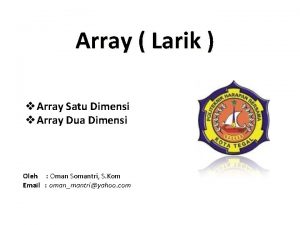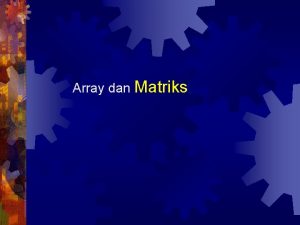Array Track A FineGrained Indoor Location System Jie














![Step 2: Ao. A spectrum generation • MUSIC algorithm [Schmidt, 1986] for Ao. A Step 2: Ao. A spectrum generation • MUSIC algorithm [Schmidt, 1986] for Ao. A](https://slidetodoc.com/presentation_image_h/825d4398b1eee7d5bcf6fe70c23deb61/image-15.jpg)


















- Slides: 33

Array. Track: A Fine-Grained Indoor Location System Jie Xiong, Kyle Jamieson University College London April 3 rd, 2013 USENIX NSDI ‘ 13

Precise location systems are important • Outdoors: GPS – – Accurate for navigation (meters) Signals fade in indoor environments • Precise and rapid indoor location enables: • Augmented reality on the smartphone, wearable or glasses • Fine-grained location in supermarkets, libraries or museums • Controlling network access based on desk or room • Known technologies: not accurate enough (Wi. Fi), require dedicated infrastructure (ultrasound) or require cameras and good light conditions (vision) 2

Timeline of indoor location systems 3 cm (Bat) Ward et al 39 -51 cm (Horus) Youssef et al 2 -3 m (RADAR) Bahl et al 1992 2004 1997 5 -10 cm (Cricket) Priyantha et al >1 m (Badge) Want et al 5. 4 m (TIX) Gwon et al 2 m (EZ) Chintalapudi et al 23 cm (Array. Track) 2012 2008 2005 2000 1 m (Pin. Loc) Sen et al 2010 30 cm (image-based) Hile and Boriello 2013 time 97 cm (Pin. Point) Joshi et al 1. 2 -4 m (Zee) Rai et al 3

Two observations about Wi. Fi 1. Increasing number of antennas on an access point (AP) • • 802. 11 n MIMO links: improve capacity and coverage Draft 802. 11 ac (2014): 8 MIMO spatial streams (8 antennas) 4 antennas 6 antennas 14 antennas 16 antennas Motorola AP 8132 Cisco Aironet 3600 Cisco Aironet 1250 RUCKUS Zone. Flex 7982 Xirrus XR 7630 4

Two observations about Wi. Fi 1. Increasing number of antennas on an access point (AP) • • 802. 11 n MIMO links: improve capacity and coverage Draft 802. 11 ac (2014): eight MIMO spatial streams 2. Wi. Fi is ubiquitous and densely deployed • • Wi. Fi is now available on airplanes, subways and buses APs density is ever-increasing in the urban environment 5

Our Approach • AP overhears a client’s transmission AP 1 • AP leverages multiple antennas to generate physical angles of arrival (Ao. A) of a client's signals: – Ao. A spectrum: power versus bearing at one AP • With multiple APs, central server synthesizes Ao. A spectra to obtain a location estimate for the client Client AP 2 6

Basic theory of operation AP x 1 Q 2πd/λ λ d I Client Measured baseband signal at AP 7

Basic theory of operation AP x 1 d θ λ/ 2 θ x 2 x 1 Q 2πd/λ I ½λ sin θ x 2 Client In a solely line-of-sight environment, phase measurements give client’s bearing to AP θ x 2 x 1 � � � arcsin � � � 8

The challenge: multipath reflections • Problem #1: Strong multipath reflections indoors • Problem #2: Direct path attenuated or completely blocked – Direct path signal may not be the strongest Ao. A spectrum Wall Array Client Furniture 1 0. 8 0. 6 0. 4 0. 2 AP 9

Array. Track’s multipath suppression algorithm • Key observation: direct path bearing is more stable than reflection path bearings when client moves slightly array AP Client 10

Array. Track’s multipath suppression algorithm 1. 2. 3. Given: Ao. A spectra from two nearby locations Find the peak bearings in each Ao. A spectrum Discard any peak not paired with a peak in the other Ao. A spectrum ✔ Two peak bearings within five degrees are considered paired 11

Step 1: detection and recording • Content of packet and modulation type do not matter • Works with any part of a packet – Array. Track utilizes the most robust preamble part 800 ns 3. 2 µs G 10 short training symbols two long trainning symbols Preamble 12

Step 1: detection and recording • Very small part of a packet needed 60 30 – For a 40 MHz sampling rate, 0 one sample is 25 ns – In the absence of noise, one sample works – Employ multiple samples for averaging to remove noise N =1 1 90 120 60 150 0. 5 180 300 60 30 0 N =10 1 90 0. 5 30 150 180 0 120 60 180 120 0. 5 240 150 N =5 1 90 30 0 N =100 190 0. 5 120 150 180 Packet body Preamble part 13

Step 1: detection and recording • Diversity synthesis: existing 802. 11 radios record the 1 st half of the preamble from antenna 1 and the 2 nd half from antenna 2 • Array. Track’s diversity synthesis algorithm – Record 10 samples from the first preamble half and another 10 samples from the second preamble half with different antennas – Double the number of antennas we can utilize for Array. Track antenna 1 antenna 2 Port 1 Port 2 1 Radio 2 Packet body Preamble part 14
![Step 2 Ao A spectrum generation MUSIC algorithm Schmidt 1986 for Ao A Step 2: Ao. A spectrum generation • MUSIC algorithm [Schmidt, 1986] for Ao. A](https://slidetodoc.com/presentation_image_h/825d4398b1eee7d5bcf6fe70c23deb61/image-15.jpg)
Step 2: Ao. A spectrum generation • MUSIC algorithm [Schmidt, 1986] for Ao. A spectrum estimation – Does not work well for indoor environment because of coherent signals: Transmitter (Client) Receiver (AP) • Spatial smoothing (SS) [Shan et al, 1985] handles coherent signals NO spatial smoothing (SS) 90 60 120 1 30 x 1 x 2 x 3 x 4 x 5 x 6 x 7 x 8 0 0. 5 150 180 SS with 2 sub−array groups 90 60 1 120 30 0 0. 5 150 180 15

Step 3: Ao. A spectra synthesis • N APs generate N Ao. A spectra 0. 8 0. 6 0. 4 P(x) = P(x 1) * P(x 2) AP 1 X 1 • For a random position X, the likelihood of being at X is a multiplication of probabilities from multiple APs 0. 2 P(x 1) =0. 45 P(x 2) =0. 6 1 0. 8 0. 6 0. 4 0. 2 AP 2 16

Step 4: search for highest probability position 17

Implementation • AP: two WARPs, each with four radio boards (eight antennas) – Custom FPGA design using Xilinx System Generator for packet synchronization, diversity synthesis, RF oscillator synchronization – 4 -16 antennas placed in a linear arrangement, spaced at λ/2 (6. 13 cm) • Clients: Soekris boxes equipped with 802. 11 radios • Backend location server: implemented in Matlab (1, 000+ Lo. C) 18

Floorplan: client and AP positions • Backend server has knowledge of each AP’s location 6 1 N AP 4 3 Client 2 5 19

Evaluation • How accurate is MUSIC + SS? • Array. Track’s multipath suppression improvement • Effect of number of antennas on each AP • Effect of client-AP differences in height 20

Effects of number of APs • Heatmap example of increasing number of APs one AP four APs two APs five APs three APs six APs 21

MUSIC + SS achieves 26 cm accuracy In general, with increasing number of APs, more accurate location information can be obtained 1 6 APs (MUSIC + SS) 0. 9 0. 8 5 APs (MUSIC + SS) 4 APs (MUSIC + SS) 3 APs (MUSIC + SS) 0. 7 0. 6 CDF • 0. 5 0. 4 0. 3 0. 2 0. 1 0 1 5 10 20 50 100 Location error (cm) 50010002500 22

Evaluation • How accurate is MUSIC + SS? • Array. Track’s multipath suppression improvement • Effect of number of antennas on each AP • Effect of client-AP differences in height 23

Multipath suppression improves accuracy 1 • Median: 23 cm (Array. Track with 6 APs) 0. 5 0 0 1 • With multipath suppression, the long tail is removed The fewer APs, the more important is multipath suppression 500 1000 1500 0 0 1 500 1000 1500 0. 5 0 0 1 2500 2000 2500 Array. Track (4 APs) MUSIC + SS (4 APs) 500 1000 1500 0. 5 0 0 2000 Array. Track (5 APs) MUSIC + SS (5 APs) 0. 5 CDF • Array. Track (6 APs) MUSIC + SS (6 APs) 2000 2500 Array. Track (3 APs) MUSIC + SS (3 APs) 500 1000 1500 Location error (cm) 2000 2500 24

Optimal subset of APs • On average, 6 APs present the best result • It’s not true for a particular position 1 0. 9 0. 8 0. 7 CDF 0. 6 2. 5 cm 23 cm 0. 5 0. 4 0. 3 Array. Track (6 APs) Optimal subsets of APs MUSIC + SS (6 APs) MUSIC + SS (3 APs) 0. 2 0. 1 0 1 5 10 20 50 100 Location error (cm) 500 25

Evaluation • Effect of number of APs on accuracy • Multipath suppression improvement • Effect of number of antennas on each AP • Effect of client-AP differences in height/orientation 26

Number of antennas at AP 1 0. 9 Array. Track 4−antenna APs Array. Track 6−antenna APs Array. Track 8−antenna APs 0. 8 CDF 0. 7 0. 6 0. 5 0. 4 0. 3 0. 2 0. 1 0 1 10 20 50 Location error (cm) 100 500 27

Evaluation • Effect of number of APs on accuracy • Multipath suppression improvement • Effect of number of antennas on each AP • Effect of client-AP differences in height 28

High accuracy despite AP-client height difference 1 ceiling Different antenna heights Original 3 m 1. 5 m CDF 0. 8 0. 6 0. 4 0. 2 0 1 10 20 Location error (cm) 100 29

Other characteristics of Array. Track Small latency (1 -3 packets needed ) Robust against low SNR Robust against collision 30

Conclusions • Array. Track: a robust, fast and responsive localization system with a median accuracy level of 23 cm (6 APs) and one meter (3 APs) – Novel multipath suppression and diversity synthesis algorithms – Uses only the Wi. Fi infrastructure nearby – Robust against low SNR and packet collisions – Fast and responsive: requires only 1 -3 packets • Three dimensional tracking with two-dimensional array for future work Thank you! 31

Implementation challenges • Wire connects WARPs to share the sampling clock and RF oscillator • USRP 2 calibrates WARPs to remove WARP internal phase offsets • Remove phase offsets due to hardware imperfections • • Cables labeled with the same lengths are not exactly the same SMA splitters are not fully balanced 32

AP-client antenna orientations • Circularly-polarized antennas mitigate the performance drop 1 Different antenna orientations Different antenna heights Original CDF 0. 8 0. 6 0. 4 0. 2 0 1 10 20 Location error (cm) 100 33
 Arraytrack: a fine-grained indoor location system
Arraytrack: a fine-grained indoor location system Indoor location timeline
Indoor location timeline Zi wo jie shao
Zi wo jie shao Verkleinwoorde
Verkleinwoorde Bbi dictionary of english word combinations
Bbi dictionary of english word combinations Wusome
Wusome Jie wu temple
Jie wu temple Gv tu jie
Gv tu jie Gv tu jie
Gv tu jie Jie wu
Jie wu Jie qin
Jie qin Būdvardžio laipsniai
Būdvardžio laipsniai Anthony badea
Anthony badea Xiong jie
Xiong jie Netbackup track log location
Netbackup track log location Land grid array vs pin grid array
Land grid array vs pin grid array Terdapat array a 3 4 2 maka jumlah elemen array tersebut
Terdapat array a 3 4 2 maka jumlah elemen array tersebut Jagged array vs multidimensional array
Jagged array vs multidimensional array Associative array vs indexed array
Associative array vs indexed array Difference between broadside array and endfire array
Difference between broadside array and endfire array Larik adalah
Larik adalah Keuntungan dari sparse array adalah
Keuntungan dari sparse array adalah Contoh array 1 dimensi dan 2 dimensi
Contoh array 1 dimensi dan 2 dimensi Photovoltaic array maximum power point tracking array
Photovoltaic array maximum power point tracking array A cross country skier moves from location a
A cross country skier moves from location a In location planning the location of raw materials
In location planning the location of raw materials Chartblocks headquarters
Chartblocks headquarters State various types of track electrification system
State various types of track electrification system Kando system of track electrification
Kando system of track electrification Getrac
Getrac Trbonet indoor
Trbonet indoor Batting cage baltimore
Batting cage baltimore Outdoor indoor sports
Outdoor indoor sports Types of games outdoor
Types of games outdoor
